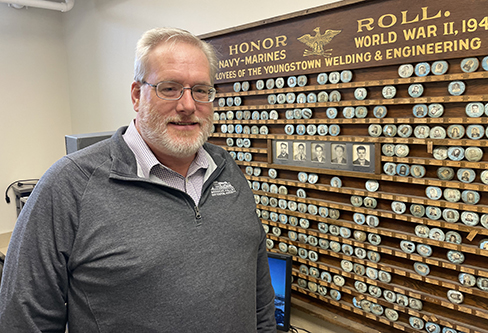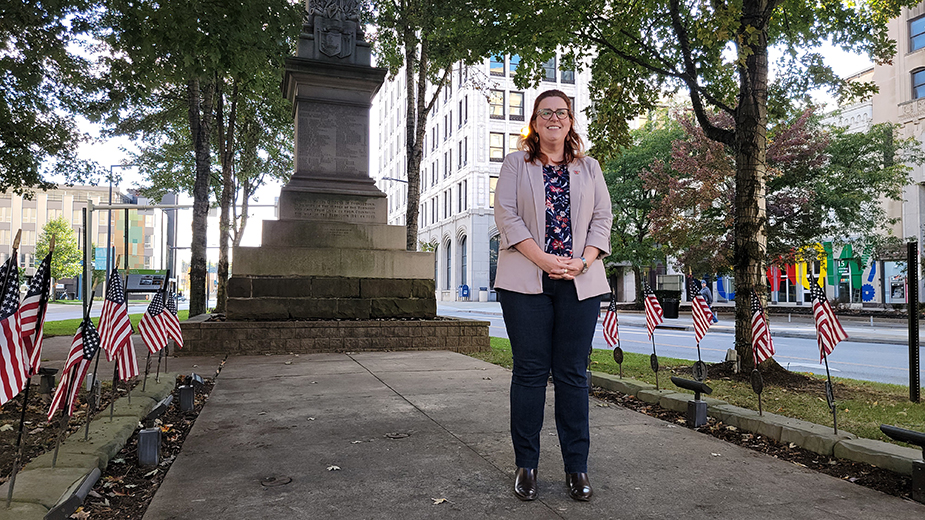YOUNGSTOWN, Ohio – Shrouded by trees that have grown up around it over 150 years, The Man on the Monument statue stands guard amid the traffic of Central Square in downtown Youngstown.
Dedicated July 4, 1870, in honor of the 108 local men who died in the Civil War, the monument depicts a soldier on a marble pedestal looking north.
It was placed in the middle of the traffic circle so that it would be a prominent feature in the city. But Central Square evolved over the decades, and now it’s a bit hidden.
“I’ve asked my students about it and maybe half of them know it’s here and maybe a quarter know it’s to the Civil War,” says Amy Fluker, a history professor at Youngstown State University.
She notes that it was erected with the belief that it would be in the heart of the community, where it could not be missed.
The Man on the Monument is not alone. Monuments honoring veterans and memorializing those who died during war can be found throughout the Mahoning Valley. But sometimes you must search for them.
“Townships, villages, neighborhoods, churches, civic organizations and clubs, schools, employers, everybody wanted to make sure that those veterans, especially who came back, knew that the community appreciated their service to the country,” says Bill Lawson, executive director of the Mahoning Valley Historical Society.
The Bristolville Township Park Civil War Memorial at the crossroads of state Routes 45 and 88 in Bristolville is the oldest from that war in Ohio, erected in 1863 – two years before the end of the Civil War, according to the Trumbull County Tourism Bureau.
Through the years, large monuments in cemeteries, parks and city squares, along with small plaques and bridge markers, were erected to honor veterans.
For instance, Fluker reflects on a section of a tree preserved in the mill building at Beaver Creek State Park, accepted to be part of the tree under which Confederate Gen. John Hunt Morgan surrendered in the northernmost incursion of the Civil War.

A plaque was erected in 1945 inside the former Woodrow Wilson High School in Youngstown. It illuminates the names of the 26 former students and the country where they died while serving in the U.S. armed forces during World War II.
“It is very poignant. But I think it also speaks to the dedication that students and faculty and administrators had to those who left school, many times dropped out of school before they graduated to serve during World War II,” says Lawson.
When the school was demolished, the plaque found a new home at the Tyler History Center, which also preserves a wooden rack from the Youngstown Welding and Engineering Co. that honored servicemen during World War II. Lawson explains when an employee was drafted or enlisted, the employee’s badge went on the rack with his name, for everyone to see. Five fallen employees are pictured in the center.
The practice of honoring servicemen and women did not end with the world wars, or the Korean and Vietnam wars.
“Almost every generation has a large group of veterans, up to current day, and when they came back, our community looked for ways to honor their service and honor their lives if they gave the last full measure in their service,” says Lawson.
Three local servicemen killed in Beirut during the bombing of the Marine barracks on Oct. 23, 1983 – Lance Cpl. Edward A Johnston of Struthers; Lance Cpl. Stanley Sliwinski of Niles; and Sgt. James E. McDonough of New Castle, Pa. – are among those honored by the Peacekeepers Memorial in Struthers. Susan Krawchyk, executive director of the Mahoning County Veterans Service Commission, notes a 40th anniversary candlelight vigil and ceremony recently took place at the Beirut memorial.
Krawchyk points to a 9/11 memorial that was built in Austintown. Efforts are underway by the Disabled American Veterans and the Austintown American Legion to raise funds to add another monument in the township’s Wickliffe Circle, this one dedicated to those who served in the Middle East.
Honoring those who served is an effort to remind people, especially the young, not to take their freedoms and lifestyle for granted, she says.
“If it wasn’t for the old-timers who came up with these ideas of honoring the people of the Valley who lost their lives, we wouldn’t have any history,” Krawchyk says.
Returning veterans and organizations often put up the memorials and now care for them. But through the years, they also functioned as advocates for veterans.
“We have to remember that in the late 19th century, veteran status did not necessarily carry with it any kind of special recognition or status,” says Fluker.
“People might have been grateful before the Civil War to people who fought for their country,” she says. “But it was really Civil War veterans who pushed for the idea that it is not only the men who died who mattered. It’s the men who are living too.”
Pictured at top: Amy Fluker, a YSU professor, at the Civil War memorial on Central Square.
